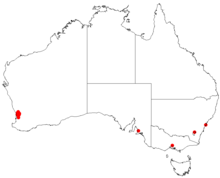Hakea cristata
Hakea cristata, commonly known as the snail hakea,[2] is a shrub in the family Proteaceae native to Western Australia. An ornamental prickly shrub with attractive foliage and creamy white rounded flowers appearing in profusion in the winter months.
| Snail hakea | |
|---|---|
 | |
| Hakea cristata | |
| Scientific classification | |
| Kingdom: | Plantae |
| Clade: | Tracheophytes |
| Clade: | Angiosperms |
| Clade: | Eudicots |
| Order: | Proteales |
| Family: | Proteaceae |
| Genus: | Hakea |
| Species: | H. cristata |
| Binomial name | |
| Hakea cristata | |
 | |
| Occurrence data from Australasian Virtual Herbarium | |

Description
Hakea cristata is a straggly, upright, multi-stemmed shrub typically growing to a height of 1 to 3.5 metres (3 to 11 ft), smaller branches smooth. The leaves grow alternately are more or less egg-shaped tapering toward the base, 4.5 to 8 centimetres (1.8 to 3.1 in) long and 2 to 5 cm (0.8 to 2.0 in) wide. The leaf margins are toothed and prickly, new growth smooth and an attractive pink-reddish colour. The smooth mid-green leaves have a central vein ending in a stiff sharp point. Each inflorescence is composed of 24-42 faintly scented cream white flowers and appear in upper leaf axils from May to August. The perianth is 2 to 4 mm (0.079 to 0.157 in) long and smooth. The style is smooth. The fruit distinguish this species having a toothed crest that runs along each side of the underside of the fruit valve ending in a triangular horn at the apex. Fruit grow at an angle on the stalk are egg-shaped 3.5 to 5 cm (1.4 to 2.0 in) long and 2.3 to 3 cm (0.91 to 1.18 in) wide. The surface has spiky toothed ridges, fruit may remain green even at maturity. The winged elliptic seeds are 3 to 3.4 cm (1.18 to 1.34 in) long.[2][3][4][5][6][7]
Taxonomy and naming
Hakea cristata was first formally described by the botanist Robert Brown in 1830 and published in Supplementum primum prodromi florae Novae Hollandiae.[1][8] The specific epithet (cristata) is derived from the Latin word cristatus meaning "tufted" or "crested",[9] referring to the crests along each side of the fruit.[3]
Distribution and habitat
The snail hakea is specifically associated with lateritic soils and granite outcrops in the Jarrah forests of the Darling Scarp between Chittering and Mundaring.[2] It is usually part of open Eucalyptus wandoo woodland communities.[3]
Notes
- "Hakea cristata". APNI. Retrieved 28 January 2019.
- "Hakea cristata". FloraBase. Western Australian Government Department of Parks and Wildlife.
- "Hakea cristata". Electronic Flora of South Australia. Government of South Australia. Retrieved 12 October 2018.
- Young, Jennifer A. (2006). "Hakeas of Western Australia:A Field and Identification Guide". J.A. Young. ISBN 0-9585778-2-X.
- Holliday, Ivan (2005). "Hakeas a Field and Garden Guide". Reed New Holland. ISBN 1-877069-14-0.
- Wrigley, John W.; Fagg, Murray (1989). "Banksias, Waratahs & Grevilleas & all other plants of the Australian Proteaceae family". Collins. ISBN 0-7322-0020-2.
- Wilson, Annette; Barker, Robyn M.; Haegi, Laurence A.; Barker, William R. (1999). "Flora of Australia" Volume 17B Proteaceae 3 Hakeas to Dryandra. Canberra/Melbourne: ABRS-Department of Environment & Heritage. ISBN 0-643-06454-0.
- Brown, Robert (1830). "Supplementum primum Prodromi florae Novae Hollandiae". Biodiversity Heritage Library.
- Brown, Roland Wilbur (1956). The Composition of Scientific Words. Washington, D.C.: Smithsonian Institution Press. p. 238.
References
- Young, J.A. (2006) Hakeas of Western Australia - A Field and Identification Guide page 31
External links
- http://www.anbg.gov.au/abrs/online-resources/flora/stddisplay.xsql?pnid=3219 Flora of Australia Online
| Wikimedia Commons has media related to Hakea cristata. |